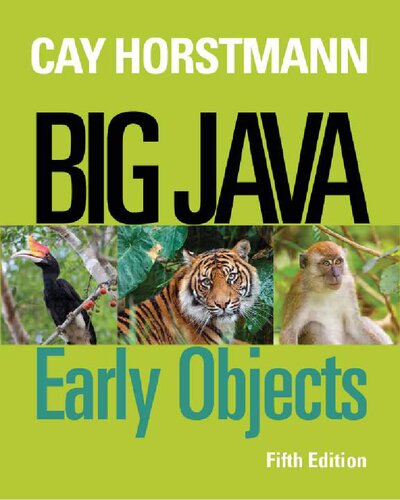

Most ebook files are in PDF format, so you can easily read them using various software such as Foxit Reader or directly on the Google Chrome browser.
Some ebook files are released by publishers in other formats such as .awz, .mobi, .epub, .fb2, etc. You may need to install specific software to read these formats on mobile/PC, such as Calibre.
Please read the tutorial at this link. https://ebooknice.com/page/post?id=faq
We offer FREE conversion to the popular formats you request; however, this may take some time. Therefore, right after payment, please email us, and we will try to provide the service as quickly as possible.
For some exceptional file formats or broken links (if any), please refrain from opening any disputes. Instead, email us first, and we will try to assist within a maximum of 6 hours.
EbookNice Team

Status:
Available5.0
19 reviews
ISBN-10 : 1118431111
ISBN-13 : 9781118431115
Author: Cay Horstmann
This book introduces programmers to objects at a gradual pace. Optional example modules are included using Alice and Greenfoot. The examples feature annotations with dos and don'ts along with cross references to more detailed explanations in the text. New tables show a large number of typical and cautionary examples. New programming and review problems are also presented that ensure a broad coverage of topics. Cay will also add sections on problem solving, and a new, more approachable and visual design developed for JfE and BJLO is used.
Chapter 1: Introduction
1.1 Computer Programs
1.2 The Anatomy of a Computer
1.3 The Java Programming Language
1.4 Becoming Familiar with YourProgramming Environment
1.5 Analyzing Your First Program
1.6 Errors
1.7 Problem Solving: Algorithm Design
Chapter 2: Using Objects
2.1 Objects and Classes
2.2 Variables
2.3 Calling Methods
2.4 Constructing Objects
2.5 Accessor and Mutator Methods
2.6 The API Documentation
2.7 Implementing a Test Program
2.8 Object References
2.9 Graphical Applications
2.10 Ellipses, Lines, Text, and Color
Chapter 3: Implementing Classes
3.1 Instance Variables and Encapsulation
3.2 Specifying the Public Interface of a Class
3.3 Providing the Class Implementation
3.4 Unit Testing
3.5 Problem Solving: Tracing Objects
3.6 Local Variables
3.7 The this Reference
3.8 Shape Classes
Chapter 4: Fundamental Data Types
4.1 Numbers
4.2 Arithmetic
4.3 Input and Output
4.4 Problem Solving: First Do It By Hand
4.5 Strings
Chapter 5: Decisions
5.1 The if Statement
5.2 Comparing Values
5.3 Multiple Alternatives
5.4 Nested Branches
5.5 Problem Solving: Flowcharts
5.6 Problem Solving: Selecting Test Cases
5.7 Boolean Variables and Operators
5.8 Application: Input Validation
Chapter 6: Loops
6.1 The while Loop
6.2 Problem Solving: Hand-Tracing
6.3 The for Loop
6.4 The do Loop
6.5 Application: Processing Sentinel Values
6.6 Problem Solving: Storyboards
6.7 Common Loop Algorithms
6.8 Nested Loops
6.9 Application: Random Numbersand Simulations
6.10 Using a Debugger
Chapter 7: Arrays and Array Lists
7.1 Arrays
7.2 The Enhanced for Loop
7.3 Common Array Algorithms
7.4 Problem Solving: Adapting Algorithms
7.5 Problem Solving: Discovering Algorithms byManipulating Physical Objects
7.6 Two-Dimensional Arrays
7.7 Array Lists
7.8 Regression Testing
Chapter 8: Designing Classes
8.1 Discovering Classes
8.2 Designing Good Methods
8.3 Problem Solving: Patterns for Object Data
8.4 Static Variables and Methods
8.5 Packages
8.6 Unit Test Frameworks
Chapter 9: Inheritance
9.1 Inheritance Hierarchies
9.2 Implementing Subclasses
9.3 Overriding Methods
9.4 Polymorphism
9.5 Object: The Cosmic Superclass
Chapter 10: Interfaces
10.1 Using Interfaces for Algorithm Reuse
10.2 Working with Interface Variables
10.3 The Comparable Interface
10.4 Using Interfaces for Callbacks
10.5 Inner Classes
10.6 Mock Objects
10.7 Event Handling
10.8 Building Applications with Buttons
10.9 Processing Timer Events
10.10 Mouse Events
Chapter 11: Input/Output and Exception Handling
11.1 Reading and Writing Text Files
11.2 Text Input and Output
11.3 Command Line Arguments
11.4 Exception Handling
11.5 Application: Handling Input Errors
Chapter 12: Object-Oriented Design
12.1 Classes and Their Responsibilities
12.2 Relationships Between Classes
12.3 Application: Printing an Invoice
Chapter 13: Recursion
13.1 Triangle Numbers
13.2 Recursive Helper Methods
13.3 The Efficiency of Recursion
13.4 Permutations
13.5 Mutual Recursion
13.6 Backtracking
Chapter 14: Sorting and Searching
14.1 Selection Sort
14.2 Profiling the Selection Sort Algorithm
14.3 Analyzing the Performance of the Selection Sort Algorithm
14.4 Merge Sort
14.5 Analyzing the Merge Sort Algoithm
14.6 Searching
14.7 Problem Solving: Estimating the Running Time of an Algorithm
14.8 Sorting and Searching in the Java Library
Chapter 15: The Java Collections Framework
15.1 An Overview of the Collections Framework
15.2 Linked Lists
15.3 Sets
15.4 Maps
15.5 Stacks, Queues, and Priority Queues
15.6 Stack and Queue Applications
Chapter 16: Basic Data Structures
16.1 Implementing Linked Lists
16.2 Implementing Array Lists
16.3 Implementing Stacks and Queues
16.4 Implementing a Hash Table
Chapter 17: Tree Structures
17.1 Basic Tree Concepts
17.2 Binary Trees
17.3 Binary Search Trees
17.4 Tree Traversal
17.5 Red-Black Trees
17.6 Heaps
17.7 The Heapsort Algorithm
Chapter 18: Generic Classes
18.1 Generic Classes and Type Parameters
18.2 Implementing Generic Types
18.3 Generic Methods
18.4 Constraining Type Parameters
18.5 Type Erasure
Chapter 19: Graphical User Interfaces
19.1 Layout Management
19.2 Processing Text Input
19.3 Choices
19.4 Menus
19.5 Exploring the Swing Documentation
Chapter 20: Streams and Binary Input/Output
20.1 Readers, Writers, and Streams
20.2 Binary Input and Output
20.3 Random Access
20.4 Object Streams
big java late objects 2nd edition
big java late objects answers
big java late objects
big java early objects answers
java late objects
Tags: Big Java, Early Late, Objects, Cay Horstmann